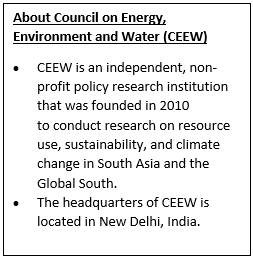SYLLABUS
GS-3: Infrastructure: Energy.
Context: Recently, the Council on Energy, Environment and Water (CEEW) released two studies that highlight that India could generate about 11 million tonnes of solar waste by 2047.
Key Findings of the Studies
• As per the study, to manage 11 million tonnes of solar waste, India requires nearly 300 recycling plants across the country and an investment of around ₹4,200 crore.
- Solar waste is electronic waste from discarded solar panels and manufacturing scrap, generated at the end of a panel’s lifespan or from damage during transport, handling, or installation.
• The studies also said that recovering and reusing materials from discarded solar panels could create a ₹3,700-crore market opportunity by 2047.
• The recovered materials could meet 38% of India’s solar manufacturing inputs and help to avoid 37 million tonnes of carbon emissions by replacing virgin resources with recycled ones.
• The study notes that solar recycling remains financially unviable in its current setup, as recyclers face losses of ₹10,000–12,000 per tonne due to high buyback and processing costs.
• Buying back used modules is the largest expense, accounting for nearly two-thirds of total costs at around ₹600 per panel.
• The CEEW suggests that profitability can be achieved if module prices fall below ₹330 or if recyclers receive support through Extended Producer Responsibility (EPR) certificates, tax incentives, and R&D funding.

• The study calls for introducing EPR targets for collection and recovery under the E-Waste (Management) Rules, 2022.
• The study recommends creating a Circular Solar Taskforce under the Ministry of New and Renewable Energy (MNRE) to coordinate policy, finance and industry action, along with a centralised solar inventory to map waste hotspots and improve transparency in material data.
Overview of Solar Waste in India
• India’s rapid solar expansion, driven by its renewable energy targets and climate commitments, has also resulted in a growing challenge of solar waste management.
• As of 31st July 2025, India’s installed solar capacity stands at 119.54 GW, marking an increase of more than 42 times from 2.82 GW in 2014.
• This surge in installations is expected to generate over 11 million tonnes of solar waste by 2047, primarily from crystalline-silicon modules, as per studies by the Council on Energy, Environment and Water (CEEW).
• While India’s emission intensity of GDP has declined by 36% between 2005 and 2020, indicating progress toward low-carbon growth, the end-of-life management of solar modules remains a pressing environmental concern.
• Currently, the solar recycling ecosystem in India is still in its infancy, with limited commercial recyclers and high costs of waste collection and material recovery.
India’s Efforts Against Solar Waste
• GST Rationalisation for Renewable Energy
- The Goods and Services Tax (GST) on solar, wind, and related renewable devices has been reduced from 12% to 5%, making clean energy technologies more affordable.
- This includes solar cookers, solar power generators, PV modules, bio-gas plants, wind mills, and waste-to-energy devices.
- The tax cut aims to lower capital costs, boost the viability of solar projects, and encourage domestic manufacturing under the Production Linked Incentive (PLI) Scheme for High Efficiency Solar PV Modules with an outlay of ₹24,000 crore.
- The reduced GST supports India’s transition towards affordable and sustainable solar infrastructure, contributing to both clean energy expansion and circular economy goals.
• Strengthening Waste Management and Circular Economy
- Under the E-Waste (Management) Rules, 2022, the government aims to embed Extended Producer Responsibility (EPR) for solar module recycling.
- The focus is on establishing a Circular Solar Taskforce under the Ministry of New and Renewable Energy (MNRE) to coordinate waste mapping, policy design, and financial incentives.
- Parallelly, GST cuts on Common Effluent Treatment Plants (CETPs) from 12% to 5% promote centralised waste treatment, reducing industrial pollution and supporting a clean manufacturing ecosystem.
• Alignment with National and Global Commitments
- These measures are aligned with India’s LiFE (Lifestyle for Environment) Movement, promoting sustainable consumption and waste reduction.
- The initiatives support India’s adherence to the Paris Agreement by reducing lifecycle emissions from renewable technologies and encouraging green industrial growth.
UPSC Mains Practice Question
India’s transition to clean energy is creating new challenges related to solar waste management. Discuss the significance of developing a circular economy for solar waste in India. Also, highlight the recent policy measures and institutional efforts taken to address this emerging concern.

